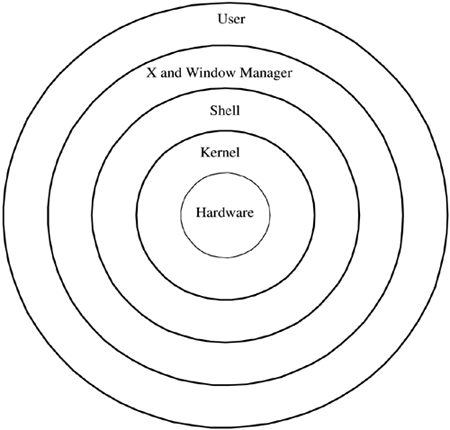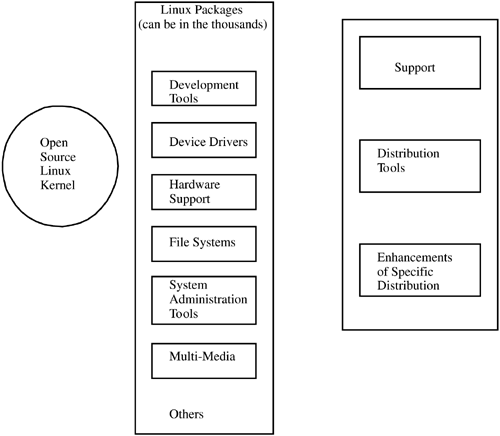Linux Components
| < Day Day Up > |
| This how-to book doesn't have a lot of background information in any of the chapters. This book illustrates how to get important tasks done. The next few pages provide some Linux background that covers the structure of Linux. Figure P-1 is a high-level depiction of a Linux system. Figure P-1. High-Level Linux System Structure
Before describing this figure, note that everyone has a somewhat different way of viewing the components of Linux. This figure contains the most important components from a user perspective. At the heart of Figure P-1 is the hardware. Linux, in its many forms, now runs on many different types of hardware. I have melded the Integrity and IA-32 hardware on which Linux runs throughout this book and have pointed out the areas of Red Hat Enterprise Linux (RHEL) that are peculiar to HP Integrity servers. The next circle from the center of this diagram is the kernel. The kernel performs many functions including management of devices, memory, and processes; scheduling and execution of all commands; and containment of drivers that control system hardware. The kernel is an aspect of the system that system administrators spend a lot of time maintaining. When a new device is configured, a device driver may have to be added to the kernel to support the new device. There is also substantial tuning that can be performed to the kernel to optimize system performance for the application(s) running on the Linux system. Users have only indirect interaction with the kernel through the commands you issue that work their way to the kernel. The next circle is the shell. The shell takes commands from you and starts the process of executing the commands. In addition to passing commands to more inner layers of the system, the shell also allows you to run commands in the background and run shell programs. The next circle is the X Window System and the window manager that you run. There is a chapter in the book covering both GNOME and KDE. You usually don't see the graphical user interface as a separate circle in such Linux diagrams, because most of the work done in a graphical user interface works its way down to a shell command. Because many Linux users use a graphical user interface, this warrants its own circle. The final circle is the user. As a system administrator, you have access to all the components in the diagram. Another way to view Linux is on a distribution basis. Figure P-1 shows Linux in a generic way. You won't be using a generic Linux: you'll be using a specific distribution, such as Red Hat Enterprise Linux (RHEL) Advanced Server on your HP Integrity servers. Figure P-2 breaks down Linux components in the way in which you'd view them as part of a distribution. Figure P-2. High-Level Linux Distribution
The high-level depiction of a Linux distribution in Figure P-2 has several components. On the far left is the Linux kernel, which is open-source software and serves as the basis for any Linux distribution. The center components consist of open source modules as well as distribution-specific enhancements. There may be, for instance, open-source system administration tools as well as distribution-specific adminstration tools that are part of a release. The components on the right are those specific to a distribution, such as the support available. An additional consideration with Itanium and operating systems is byte ordering. This is often referred to as the endian of an architecture or operating system. Itanium doesn't care about byte ordering and can support both byte ordering methods. Operating systems that store the most significant byte in the leftmost position are big endian. Operating systems that store the most significant byte in the rightmost position are little endian. Linux is a little endian operating system. Linux and Windows are little endian and HP- UX is big endian. All these operating systems run on HP Integrity servers. Some examples in this book use the "retail" release of Red Hat version 8.x. The "retail" releases of Red Hat, such as 8.x, have been replaced by Fedora. The Fedora Project is a Red Hat-sponsored and community-supported open-source project. Fedora Core 2 is available at the time of this writing. |
| < Day Day Up > |
EAN: 2147483647
Pages: 100

